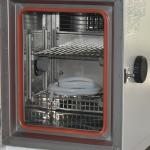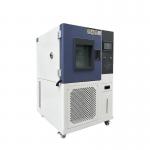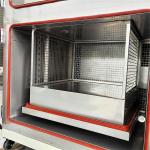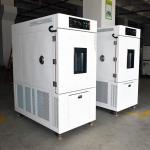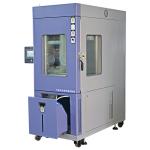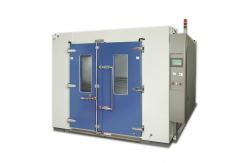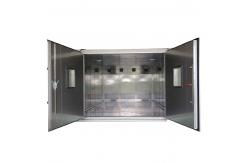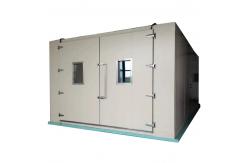In the dynamic and highly technical field of photovoltaic (PV)
module testing, the need for specialized and accurate environmental
testing equipment is paramount. Testing organizations require tools
that can replicate the diverse and often extreme conditions that PV
modules may encounter during their lifespan. The Simulated PV
Module Landing Type Temperature Humidity Chamber is designed to
meet these exacting demands. This large environmental test chamber is specifically crafted to
subject PV modules to a comprehensive range of temperature and
humidity conditions. It serves as an invaluable asset for testing
organizations involved in the PV industry. The primary purpose is
to evaluate the performance, durability, and reliability of PV
modules under conditions that mimic real-world scenarios, including
those during installation, operation, and exposure to various
climates. By precisely controlling temperature and humidity levels,
it allows for the identification of potential weaknesses or failure
points in PV module designs, ensuring that only the highest quality
and most resilient modules reach the market. - Robust and Customizable Construction
- The chamber is constructed with a heavy-duty framework, typically
made of corrosion-resistant steel, to withstand the rigors of
continuous testing and the unique demands of PV module evaluation.
The interior is designed to accommodate different sizes and
configurations of PV modules, with adjustable racks and supports
that can be customized to fit specific module dimensions. The
lining of the chamber is made from a non-reactive and smooth
material, such as stainless steel or a specialized polymer, to
prevent any interaction between the chamber environment and the PV
modules. The door of the chamber is engineered for a tight seal,
featuring a reliable locking mechanism and a heavy-duty gasket. It
also includes a large viewing window, usually made of tempered
glass with anti-fog and anti-scratch properties, allowing for
continuous visual monitoring of the testing process without
disturbing the internal environment.
- Precision Temperature and Humidity Control Systems
- Temperature Control: The temperature control system is highly
accurate and can maintain a wide temperature range, typically from
-40°C to +80°C, with an accuracy of ±0.3°C. It utilizes advanced
refrigeration and heating technologies, along with a sophisticated
feedback loop and multiple temperature sensors strategically placed
throughout the chamber. This ensures uniform temperature
distribution across the PV module, which is crucial for obtaining
accurate and reliable test results. The system also has built-in
safety features to prevent overheating or overcooling, protecting
both the PV modules and the chamber itself.
- Humidity Control: The humidity control system is equally precise,
capable of adjusting the relative humidity from 10% to 95% RH, with
an accuracy of ±2% RH. The chamber is equipped with a
high-efficiency humidifier and dehumidifier, which work in harmony
to achieve rapid and accurate humidity adjustments. Special care is
taken to prevent condensation, which could affect the test results
and damage the PV modules. The system also features a dew point
control function, which is crucial for maintaining the correct
moisture balance in the chamber.
- Programmability: The chamber's control panel is highly
programmable, allowing users to create and store complex
temperature and humidity profiles. This enables the simulation of a
wide variety of environmental conditions, from the harsh desert
climates with extreme heat and low humidity to the humid tropical
regions with high heat and moisture levels. It can also mimic the
temperature and humidity changes that occur during different
seasons and times of the day. The control panel is user-friendly
and intuitive, with a clear display that shows the current
temperature, humidity, and the status of the testing program.
- Advanced Instrumentation and Data Acquisition
- The chamber is outfitted with a comprehensive suite of sensors.
Temperature sensors are distributed evenly to detect any
temperature gradients and ensure a homogeneous thermal environment.
Humidity sensors provide real-time data on the relative humidity
levels. These sensors are connected to a state-of-the-art data
acquisition system that records and stores all the measured data.
The data can be accessed and analyzed in real-time or retrieved
later for in-depth studies. The data acquisition system is highly
flexible and can be integrated with external software and
databases, facilitating seamless data transfer and analysis. It can
also be configured to send notifications and reports automatically,
saving time and effort for the users. Additionally, the control
panel includes built-in alarms and safety features that alert users
in case of any abnormal conditions, such as temperature or humidity
excursions outside the set limits, power failures, or equipment
malfunctions.
- Volume and Dimensions: The chamber is designed with a large volume to accommodate
multiple PV modules simultaneously. The interior dimensions are
carefully optimized to ensure efficient use of space and proper air
circulation. The external dimensions are configured to fit within
the testing facility, taking into account factors such as access,
ventilation, and clearance. Typically, the chamber may have a width
of around 2 to 3 meters, a depth of 2 to 3 meters, and a height of
2 to 3 meters, depending on the specific requirements.
- Temperature Uniformity: The temperature uniformity within the chamber is maintained
within ±0.5°C. This ensures that all parts of the PV modules
experience a similar thermal environment, which is essential for
accurate testing. Any significant temperature differences across
the module could lead to inaccurate performance evaluations and
potential misdiagnosis of module quality.
- Humidity Uniformity: The humidity uniformity is within ±3% RH. This level of
consistency in humidity distribution allows for precise testing of
PV modules, as moisture can have a significant impact on their
electrical and physical properties.
- Stability: Both the temperature and humidity stability are excellent, with
minimal fluctuations over time. This allows for long-term testing
and the evaluation of a PV module's performance under stable
environmental conditions, as well as its ability to withstand
changes over extended periods.
- Accurate Simulation of PV Module Environmental Conditions
- The primary function of this chamber is to provide a highly
accurate and realistic simulation of specific temperature and
humidity conditions that PV modules may face. By precisely
controlling these parameters, it allows testing organizations to
evaluate how PV modules will behave in various real-world
situations. For example, in regions with high temperature and
humidity, PV modules may experience a decrease in efficiency and
potential degradation of their components. The chamber can
replicate these conditions, enabling manufacturers to develop
strategies to mitigate such effects, such as improving the module's
encapsulation or using more heat-resistant materials.
- The ability to create complex environmental profiles, such as
cyclic temperature and humidity changes, is also a valuable
function. This can help in understanding how PV modules will
respond to the changing conditions they may encounter throughout
the day and over the seasons. For instance, a module that is
exposed to daily temperature cycles may experience stress-induced
damage over time, and this chamber can accurately replicate such
scenarios to determine the module's durability and performance over
its lifespan.
- Enhanced PV Module Quality and Reliability
- Through comprehensive testing in the chamber, manufacturers can
identify and address potential issues in their PV module designs.
If a module shows signs of degradation or performance reduction
under specific temperature and humidity conditions, appropriate
measures can be taken, such as modifying the cell layout, improving
the interconnect technology, or enhancing the thermal management
system. This leads to the development of more stable and reliable
PV modules, reducing the risk of failures and increasing the
overall efficiency and lifespan of solar power systems. It also
helps in optimizing product warranties and service intervals, as
manufacturers have a better understanding of the module's
durability under different environmental stressors.
- The test chamber also serves as a powerful tool for research and
development. It allows scientists and engineers to study the
effects of temperature and humidity on new PV materials and module
designs. For example, in the field of PV research, the chamber can
be used to investigate the behavior of emerging semiconductor
materials under different temperature and humidity conditions,
leading to the discovery of new materials with improved performance
and durability.
- Compliance with PV Industry Standards and Regulations
- The photovoltaic industry is highly regulated, and there are strict
standards regarding the testing of PV modules under specific
temperature and humidity conditions. The Simulated PV Module
Landing Type Temperature Humidity Chamber is a reliable tool for
ensuring compliance. For example, international standards such as
IEC 61215 and IEC 61730 require PV modules to undergo a series of
temperature and humidity tests to evaluate their durability and
safety. By using this chamber to conduct tests in accordance with
relevant standards, manufacturers can prove that their products
meet the necessary criteria, facilitating market access and
enhancing consumer confidence. Regulatory bodies rely on accurate
test results obtained from such chambers to enforce safety and
quality regulations.
|
